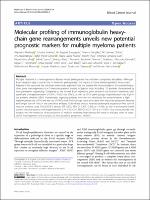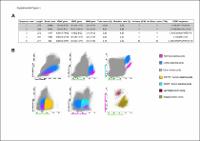| dc.contributor | Vall d'Hebron Barcelona Hospital Campus |
| dc.contributor.author | Medina, Alejandro |
| dc.contributor.author | Jimenez, Cristina |
| dc.contributor.author | Sarasquete, Maria Eugenia |
| dc.contributor.author | González, Marcos |
| dc.contributor.author | Chillón, M. Carmen |
| dc.contributor.author | Balanzategui, Ana |
| dc.contributor.author | Gironella Mesa, Mercedes |
| dc.date.accessioned | 2021-09-09T05:52:15Z |
| dc.date.available | 2021-09-09T05:52:15Z |
| dc.date.issued | 2020-02-06 |
| dc.identifier.citation | Medina A, Jiménez C, Sarasquete ME, González M, Chillón MC, Balanzategui A, et al. Molecular profiling of immunoglobulin heavy-chain gene rearrangements unveils new potential prognostic markers for multiple myeloma patients. Blood Cancer J. 2020 Feb 6;10:14. |
| dc.identifier.issn | 2044-5385 |
| dc.identifier.uri | https://hdl.handle.net/11351/6280 |
| dc.description | Investigación genética; Mieloma |
| dc.language.iso | eng |
| dc.publisher | Springer Nature |
| dc.relation.ispartofseries | Blood Cancer Journal;10 |
| dc.rights | Attribution 4.0 International |
| dc.rights.uri | http://creativecommons.org/licenses/by/4.0/ |
| dc.source | Scientia |
| dc.subject | Mieloma múltiple |
| dc.subject | Regulació genètica |
| dc.subject.mesh | Multiple Myeloma |
| dc.subject.mesh | Gene Expression Regulation, Neoplastic |
| dc.title | Molecular profiling of immunoglobulin heavy-chain gene rearrangements unveils new potential prognostic markers for multiple myeloma patients |
| dc.type | info:eu-repo/semantics/article |
| dc.identifier.doi | 10.1038/s41408-020-0283-8 |
| dc.subject.decs | mieloma múltiple |
| dc.subject.decs | regulación de la expresión génica neoplásica |
| dc.relation.publishversion | https://doi.org/10.1038/s41408-020-0283-8 |
| dc.type.version | info:eu-repo/semantics/publishedVersion |
| dc.audience | Professionals |
| dc.contributor.organismes | Institut Català de la Salut |
| dc.contributor.authoraffiliation | [Medina A, Jiménez C, Sarasquete ME, González M, Chillón MC, Balanzategui A] Hospital Universitario de Salamanca (HUSAL), IBSAL, IBMCC (USAL-CSIC), CIBERONC, Salamanca, Spain. [Gironella M] Vall d’Hebron Hospital Universitari, Barcelona, Spain |
| dc.identifier.pmid | 32029700 |
| dc.identifier.wos | 000512747500001 |
| dc.relation.projectid | info:eu-repo/grantAgreement/ES/PE2013-2016/PI15%2F01956 |
| dc.relation.projectid | info:eu-repo/grantAgreement/ES/PE2013-2016/CB16%2F12%2F00233 |
| dc.relation.projectid | info:eu-repo/grantAgreement/ES/PE2013-2016/CPII18%2F00028 |
| dc.rights.accessrights | info:eu-repo/semantics/openAccess |

 Área privada
Área privada Contacto
Contacto








